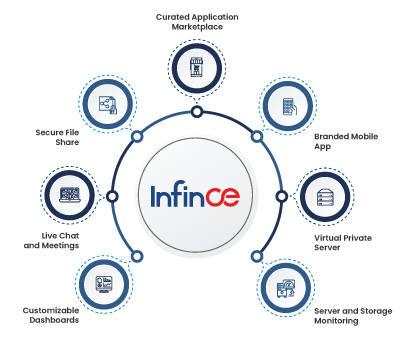Goals of increased employee productivity and cost savings are a no-brainer in today’s digitally transformed business landscape. As Rodney Zimmel from McKinsey Digital observes, the whole point of digital transformation isn’t exactly to become digital. It’s actually to drive value for the business. And that value comes from understanding clearly how to move from a physical workspace to a hybrid or a digital workplace platform.
Embracing a digital workplace is crucial for businesses looking to increase productivity, enhance collaboration, and reduce costs. The COVID-19 pandemic has been a key accelerator of the perceptive shift to the digital workplace.
Read More: The Definitive Guide to Perfect Digital Workplace Solution
In this blog, we’ll discuss the 8 key considerations you need to make while you make the much needed transition to a digital workplace. From the benefits to caution areas, to potential pitfalls – we have the rundown.
- The Covid-19 pandemic as a watershed movement: The COVID-19 pandemic has accelerated the need for businesses to shift to a digital workplace, leading to improved efficiencies, cost savings, and a more agile workforce. According to a study by PwC, companies that adopt digital workplace technology experience a 67% increase in productivity. Additionally, Gartner estimates that the digital workplace market is expected to grow at a compound annual growth rate of 14.6% from 2020 to 2027, reaching $45.7 billion by 2027. Deloitte reports that businesses can save up to $11,000 per employee annually by adopting a digital workplace platform. With the rise of automation and artificial intelligence, businesses need to embrace digital transformation and stay ahead of competition. Failure to do so could result in a loss of market share and diminished profitability.
- Investment in tools and technologies: To enable a successful digital workplace, businesses must invest in the right tools and technologies. This includes video conferencing, instant messaging, project management software, cloud storage, and more. These tools enable employees to communicate and collaborate, regardless of their location or time zone. Additionally, digital workplace tools and technologies offer companies the opportunity to enhance the employee experience, leading to better retention rates and improved employee satisfaction. Access to online training and development programs, as well as digital resources and tools for wellbeing, help employees to feel valued and supported by their employers. A case in point is Accenture, which has implemented a platform called “Collaboration 2.0.” This platform offers employees a range of tools and services to simplify and enhance collaboration and communication, including instant messaging, video conferencing, and document-sharing capabilities. Accenture has reported increased productivity and employee engagement as a result of Collaboration 2.0.
- The need for continuous upskilling and training: As businesses shift to digital workplaces, it’s essential to upskill and train employees to use the latest technologies effectively. This can be done through online training, workshops, and mentorship programs. Upskilling employees can also boost morale and improve job satisfaction as employees feel valued and equipped with the skills to succeed in a digital workplace. A key example to highlight this is AT&T, which created a Future Ready Employee initiative aimed at providing ongoing upskilling and reskilling to workers while providing them with new career development paths. As a result, they have improved employee retention by 14% and accelerated digital transformation.
- Cybersecurity as a crucial tenet: As businesses shift to a digital workplace, cybersecurity becomes a crucial consideration. Cyber threats such as phishing, ransomware, and malware can wreak havoc on a business’s operations, leading to data loss and financial losses. To maintain business continuity, it is important to stay wary of cyber attacks that can bring business operations to a complete halt, causing a loss in productivity and revenue. Educating employees on cybersecurity best practices and investing in strong cybersecurity measures, such as password management and two-factor authentication, is critical in mitigating these risks.
- Remote work as a key cost-effective driver: Remote work has become increasingly popular in recent years, with the pandemic intensifying the trend. Remote work offers many benefits, such as cost savings and increased productivity. However, managing a remote team can be challenging, requiring strong communication and collaboration tools and a clear structure for managing tasks and deadlines.
- Change management: Shifting to a digital workplace requires a shift in thinking and behavior, which can be challenging for some employees. Change management is critical in managing resistance to change and ensuring a smooth transition. This involves involving employees in the process and providing them with the support and training necessary to adapt to the new reality. Training employees to get up to speed with the latest tools and technologies is key to successful implementation of a digital workplace platform. The risk of working in silos is also cut to a great degree if there is a cohesive change management plan that drives key resources toward a co
- Generative AI and the future of work: The future of work is set to be increasingly digital, with emerging technologies such as artificial intelligence, machine learning, and virtual reality playing a significant role. Businesses must continue to invest in digital tools and technologies to remain competitive and harness the potential benefits these technologies offer.
- Processes and best practices: To successfully shift to a digital workplace, businesses must adopt best practices. This includes creating a digital transformation roadmap and involving employees in the process.
- Create a clear digital transformation roadmap: Develop a clear roadmap that outlines your goals, timeline, process, and milestones. This will ensure that everyone in your organization understands the direction of the digital transformation.
- Involve employees in the process: Employees are key stakeholders in the transformation process, and their involvement is crucial for the success of the project. Get them involved in brainstorming sessions, focus groups, testing, and feedback.
- Secure buy-in from leadership: Secure the buy-in from senior leadership to ensure that the transformation receives the necessary resources and support. This will demonstrate the importance of the project and its impact on the organization’s growth.
- Evaluate and choose the right digital tools and platforms: Carefully choose the digital tools and platforms that fit your organization’s needs and culture. Ensure that the tools provide the required features and functionality to achieve your goals.
- Train and support employees: Ensure that your employees have appropriate training and support throughout the transformation process. Provide training for new tools and processes to improve their adoption and comprehension.
- Measure the success of the transition: Regularly review the progress of the transformation using metrics that are relevant to your goals. Assess the results and adjust plans where necessary to achieve intended outcomes.
- Ensure data security and privacy: Implement appropriate data security measures to protect data and comply with applicable laws and regulations.
- Simplify processes and eliminate redundancies: Use the transformation to simplify processes and eliminate redundancies. This will optimize the use of resources and reduce costs.
- Foster a culture of innovation and continuous improvement: Encourage innovation and continuous improvement in your organization by creating a culture that promotes creativity, experimentation, and learning.
- Communicate effectively: Communicate the transformation plans and progress consistently and openly with all stakeholders, partners, and employees. This will ensure that everyone is aware of the efforts and the benefits of the transformation.
In addition to this, the implementation of best practices needs to be reviewed to get a tangible measure of success. Therefore, defining key performance indicators against very specific goals is crucial in ensuring the transition is successful.
Read more: Role of a Digital Workplace Platform in Hybrid Workplace
In conclusion, the shift to a digital workplace is essential for any business looking to remain competitive in an increasingly digital world. The benefits of enhanced collaboration, increased productivity, and cost savings are significant, but the transition requires careful planning, investment in the right tools and technologies, and upskilling and training employees.
To know more about how Infince can take your business to new heights, connect with our experts today!






